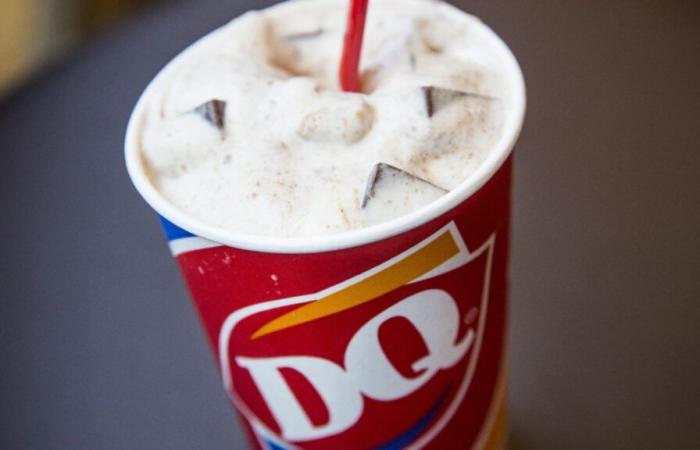Specializing in frozen desserts and burgers, the American fast food chain Dairy Queen wants to open restaurants in France.
America is definitely interested in France. Following the path opened by the founding father McDonald’s, followed by a whole cohort of other American giants, a new king of fast food is still hoping to cross the Atlantic – this time, it’s more of a queen. The fast food chain Dairy Queen plans to open restaurants in France in the coming years, the American company announced to BFM Business. Specializing in frozen desserts, it now has 7,500 restaurants worldwide, an offering comparable to that of Taco Bell (8,000 restaurants) or Wendy’s (7,000 restaurants).
France “is a strategic market for Dairy Queen”, confirms its international general manager, Nicolas Boudet, to BFM Business.
The American brand wants to rely on a local partner to develop a franchise model. “Nothing has been signed yet”, but “we are listening carefully to those who have approached us”, Nicolas Boudet emphasizes, adding that he is looking for an “experienced” group accustomed to fast food.
No date has been formally set in the calendar. “It can go faster or slower” depending on the potential partner, he specifies, mentioning 12 to 16 months needed, after finding it, to open the first restaurants. Dairy Queen should therefore not be able to set up in France before 2026 or 2027 at the earliest, if discussions prove conclusive.
Although only a few restaurants will open initially, the American brand is ambitious: “100 to 200 restaurants seem to be a minimum” to eventually reach a critical size on the French market, says Nicolas Boudet.
Already present in the Americas, Asia and the Middle East, this is not the first time that the group has tried to set up in Europe, with unsuccessful attempts having already taken place in Italy and Slovenia. In 2015, it announced its arrival in Poland, but the restaurants closed their doors the following year. “We had some failures,” he admits, which “allowed us to learn what not to do.”
“When we see what brands like McDonald’s or Burger King have been able to do” in France, “it gives us a lot of hope,” says Nicolas Boudet.
France could be the start of Dairy Queen’s return to the Old Continent. It must be said that the country is whetting appetites for fast food: fast-food chains, especially American ones, have multiplied there in recent years. Nothing to scare it off. On the contrary, it is the success of its competitors that has convinced the chain of the merits of its French intentions.
“It is an indicator of the good health of the French market”, “a mature market”, we want to believe. With its two-legged model, one based on frozen desserts and the other on hot products, Dairy Queen still sees a place to take in the stomachs of French customers.
Burgers and frozen desserts
Frozen desserts take up a good portion of the menu, starting with its flagship product, the “Blizzard,” a kind of whipped ice cream served in a large cup (it’s more like the McFlurry sold by McDonald’s, an imitation of the Blizzard, than a normal ice cream).
Its restaurants also offer a range of hot products typical of fast food, mainly burgers. A way of occupying the catering market throughout the day, of treading on the toes of both the Burger King menu at lunchtime and those of Starbucks coffee or Dunkin’ donuts in the middle of the afternoon.
The parent company International Dairy Queen, headquartered in Minnesota, has been owned since the late 1990s by the conglomerate Berkshire Hathaway, the investment company of American financier and billionaire Warren Buffett. It had revenues of $6.37 billion in 2023.
A French fast-food Eldorado… but until when?
Five Guys, Chipotle, Steak’n Shake, Carl’s Jr, Popeyes, not to mention the comeback of Burger King: the French fast food market has been punctuated, in recent years, by the successive arrivals of new American brands. Until the early 2000s, McDonald’s reigned almost unchallenged in France. Many brands are now jostling in the streets of city centers and the aisles of shopping centers.
To which should also be added the donut specialists, Dunkin’ and Krispy Kreme, also newcomers, and even Starbucks coffee shops, which are banking on drive-throughs to continue their growth in France. Other brands are waiting at the doorstep of France, such as the giant Wendy’s, which is trying its luck again in Western Europe after a previous failure. Little Caesars, the third largest pizza chain in the world, is also keeping an eye on it.
If the brands are rushing to our doors, it is already because there are fewer of them than elsewhere, such as in Spain or the United Kingdom. In addition, they benefit from a good price image in the mind of the consumer and offer conventional and universal products, easy to consume at any time of the day. And the hegemony of McDonald’s, long a brake on the arrival of competitors, is today less resistant.
But should we fear saturation? For the time being, fast food is showing good growth in France, but competition has clearly increased. In addition to American chains, we must also deal with the emergence of French brands (Big Fernand for example) and the current popularity of kebabs and tacos. Especially since some brands have already suffered failures: in 2018, Popeyes failed its first attempt in the south of France.
Jeremy Bruno BFMTV journalist






